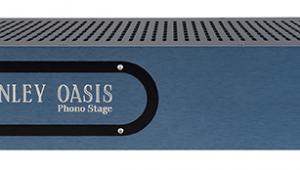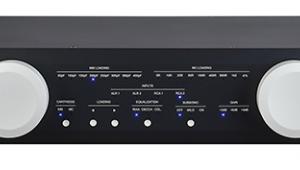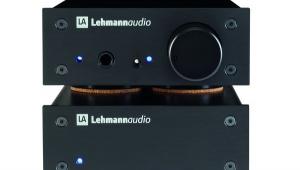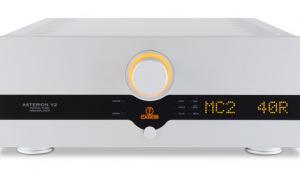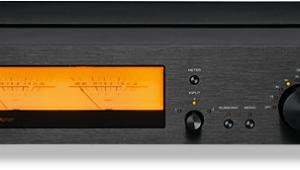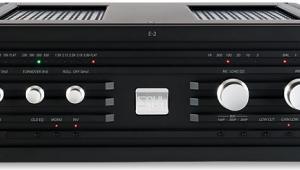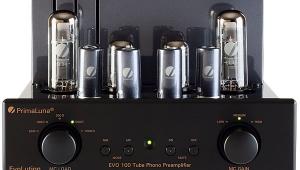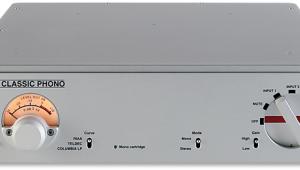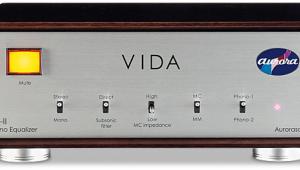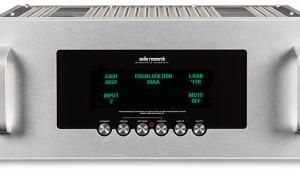Esoteric E 03 (£4795)
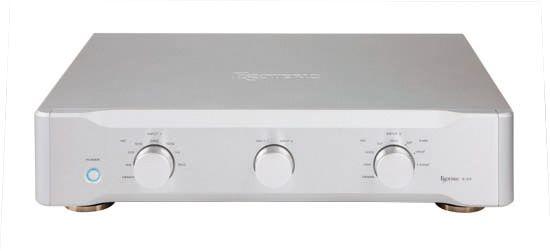
We’ve come so far down the digital path that we’re at a stage where there’s been a near-complete volte face in expectations: where once we awaited digital products from companies with their roots in analogue, we now entertain analogue products from companies with their roots in digital.
Now, I am not suggesting for a moment that there are Theta, dCS or Wadia-badged moving-coils or turntables waiting in the wings, but neither did I expect to review a masterpiece of a phono stage from Esoteric.
TEAC’s flagship division has, of course, dipped its toe in the analogue pool before, not least with a run of limited edition LPs, and I seem to recall an integrated amp with a phono section. But the E-03 – dubbed a ‘Phonostage Preamplifier’ by the company, more of which anon – exhibits everything about the brand that makes it such a formidable contender amongst the most extreme of the no-compromise digital hardware manufacturers. To imagine a phono stage as worthy as the brand’s transports, DACs and players… now that’s something worth craving.
TWO TURNTABLE INPUTS
Anyone familiar with Esoteric wares will recognise immediately the luxurious finish, the faultless design, the can’t-keep-your-hands-off-’em controls. The stuff looks expensive, feels expensive and – thankfully – sounds expensive, and has never failed to charm this listener, either at shows, or within my own system.
The E-03 slipped right in, between an Audio Research REF 5 preamplifier and a brace of record decks – an MC-equipped Linn LP 12 and an SME 30/12 fitted with a variety of MCs of varying values and a couple of MMs.
Note the mention of two decks: the E-03 is clearly the product of a culture (Japan) where multiple record deck ownership is not considered eccentric. In practical terms, it allows the most fastidious of listeners to maintain, for example, one deck for mono, with a proper mono cartridge, and another for stereo. One could run a turntable for 78s, or use different cartridges for different record labels, or any of a host of other uses. Hence, the Esoteric dedicates one set of inputs to MC cartridges while the other accommodates both MM and MC cartridges.
COMES WITH DEMAGNETISER
In order to show you just how comprehensive this unit is – and, yes, I know that there are rivals from Manley, Boulder, Audio Research, AudioValve, EAR-Yoshino, EMT and many others with similar or even greater flexibility – I’ll relay the numbers. Input 1 provides settings of 10, 50, 100, 300, 500, 1k and 10kohms for MC only, while Input 2’s MM/MC settings cover 100, 500, 1k and 10kohms, with capacitance settings of 0pF, 100pF and 330pF for the 47kohm MM positions.
While this will not exactly set a’flutter the hearts of either Decca/London devotees nor those who use Audio Note Ios, the selection is wisely considered, the values populist enough to satisfy the majority of requirements. Because I want this review to be about the E-03 and not about my choice of cartridges-by-model-number, I will say only that the MMs (Shure and Ortofon) were not outré enough to agitate the Esoteric, and the assorted MCs I used from Lyra, Koetsu, Linn and Air Tight were used at 50, 100, 500ohm and 1kohm settings, as well at 47kohms and were so consistent in their purity that I can reveal, with hand on heart, that the E-03 presented as level a playing field for as wide a range of cartridges as most of us are likely to encounter. Save for truly freakish designs such as the aforementioned Deccas and Audio Notes of this world.
Both inputs also include cartridge demagnetising settings, but that is a quasi-religious experience to which I adhere, although, equally, I can understand others being dismissive of it. In the context of this device, it is wholly appropriate if one is to surmise that the designer was trying to make this appeal to a wide audience.
Where the E-03 confuses is not in what’s included, but in what was left out. This is a heavy unit at 10.5kg, and it takes up the space of a full-blown preamplifier, sufficiently ample to house its true dual-mono circuitry with matching R-core power supply transformers and audio boards for each channel. As a result, the separation and absence of inter-channel confusion were impeccable: the headroom, expansive; the quietness, ghostly.
Its size and complexity suggested a kitchen-sink approach. But something nagged at me. Here was a device that called itself a preamplifier, and yet it offered only fixed output levels. By my reckoning, a preamplifier controls output levels, not simply signal routing. The wonderful, joyous E-03 positively screams for a volume control, for purists who would just love to feed it straight into a power amplifier.
This, of course, led me to wonder about another omission: surely, at this level, balanced XLR outputs are not too much to ask for? Or do I simply imagine that every single balanced set-up I’ve heard bettered the single-ended iteration? This, of course, is being churlish in the most offensive audiophile manner. I’ve already intimated that this is a phono stage of note. But am I wrong to think that there might be even more? For that matter, would I even recognise it, given that this unit – in plain vanilla, single-ended mode – is so spectacularly coherent and competent that to want more is to exhibit selfishness of the most unholy sort…
JUST FLOATING
It started with the first record I played, an LP I just can’t seem to wrest from my turntable: the Left Banke’s Walk Away Renee on Sundazed. I can’t implore you enough to buy this exquisite slice of melodic and delicate ‘Baroque rock’, so tuneful as to be instantly memorable, so fragile as to appear ephemeral.
The voices, reminiscent of the Hollies in their gracefulness, complement the ostensibly anachronistic instruments that seem better suited to a score for an 18th-century period piece. Such gossamer-like notes demand of a retrieval system a level of poise and elegance that musical snobs of an earlier decade would have adjudged as solely the province of string quartets.
Heard through assorted amplifiers driving the Wilson Sophia 3s, with a brief burst through the terrifying NAT Utopia/Transmitter SET pairing [review next month], the album acquired a lightness that I can only compare to the sort of froth that radical chefs apply to myriad dishes. Sea foams, infusions, or whatever other lunatic imaginings waft forth from El Bulli or The Fat Duck, the impression is one of airiness, of notes floating in the room. The transience is a positive, not the presentation of the sounds in a rootless, aimless way, but in a manner that divorces them from the apparent physical constraints of the system itself. It is as much a part of the speakers’ ability to ‘disappear’ as it is of this phono stage to serve without intrusion. But I hadn’t heard such transparent, open, diaphanous playback of this album through any other system – not even with my mint original copy.
With the up-to-the-minute sonic experience of Nick Lowe’s latest album, the utterly intoxicating The Old Magic, he delivers a lush performance amidst the leaner material in ‘Restless Feeling’, which smacks of circa-1959 CBS-grade arrangements, or of a Les Paul and Mary Ford ‘liquidity’ that slithers and sloshes and sails. The Esoteric added no transistor brittleness, no edges, no unwanted sibilants. Lowe’s ‘early rock’n’roll balladeer’ pastiche, ‘Sensitive Man’, delivers a bona-fide Ricky Nelson experience on every level, from the percussion arrangements to the backing harmonies. The E-03 spread the sound in a slight arc in front of the listener, the sides in line with the speakers, the middle slightly recessed. It was so convincing that one imagined an intimate theatre-in-the-round, sitting a third of the way back.
After the spare ‘I Read A Lot’ – which could have been performed in any dead-end bar in the world, for the late-night stragglers – provided the E-03 with a chance to sound mellow, I couldn’t resist spinning some Nat ‘King’ Cole from Analogue Productions. Though over 50 years older than Lowe’s bar nocturnes, the silkiness and intimacy were identical. I don’t know whether to compliment Lowe, or Esoteric.
GETTING IN BAD COMPANY
For those who have no interest whatsoever in the gentle, the subdued or the restrained, the Esoteric does know how to rock, to let its hair down. The party noises of Sam the Sham & The Pharoahs’ singles collection on Sundazed (mono, natch) punched through the air, sax ripping holes in the fabric just vacated by Mathis-grade strings, cheesy Farfisa keyboards squealing like little piggies, with a forwardness that emulated all of the snap of AM radio. Only instead of the compression and noise you’d get with a crappy transistor radio, it was part of a greater whole, with body and impact.
When the air-guitarist inside me can’t be silenced, I find a dose of Bad Company to be just the ticket. ‘Can’t Get Enough’ – arguably the most truly definitive ‘cock rock’ anthem of all time – provides juicy bass, sharp, almost violent drumming and the pure posturing of Mick Ralphs’ priceless guitarwork. The Esoteric simply soared with this, following every stretched, grimace-inducing fretboard stranglehold. The bottom end was rich, properly weighted, and amusingly free of the dryness that often taints phono amps devoid of glassware.
No lead break, though, ever rips at my heart the way Elvin Bishop’s does in the full-length version of ‘Fooled Around And Fell In Love’. Then again, he’s just mirroring the aching delivery of Mickey Thomas, conveying one of the most heartfelt performances I have ever heard. With icy, chiming piano tinkling in the background, a true belter of a singer handling lyrics of the most confessional sort, every note straining either the vocal chords or the guitar strings, the chills are unavoidable.
With both precision and panache, the Esoteric perched Bishop’s notes in the room, sharp and clean when needed, raw and bleeding as required. Three minutes and 30 seconds in, and you’ll be begging her, too, to forgive the poor schmuck. The sound is that convincing.
VERDICT
We’re awash with sublime, if expensive phono stages – spoilt for choice. The Esoteric makes choosing easier, for it bridges the gap between the warmth of the all-tube designs and the antiseptic nature of the purely solid-state. Its flexibility is a boon, but the clincher may be more mundane: the E-03 is so gorgeous, such a joy to use that you’ll love it as much for the wrong reasons as for all of the right ones.
Originally published in the December 2011 issue


